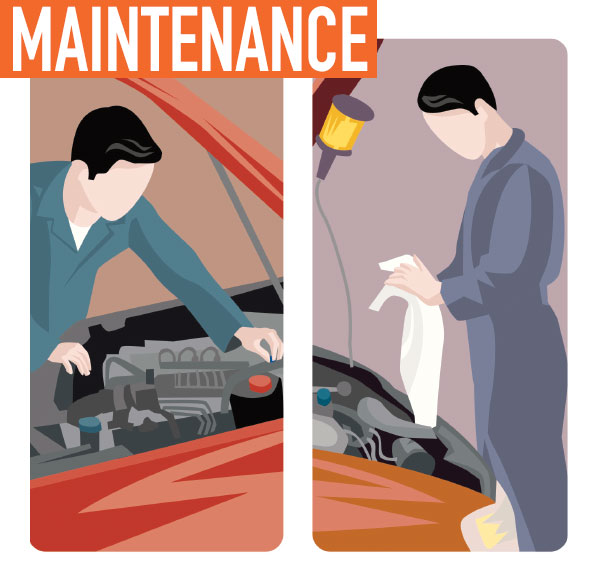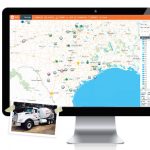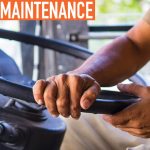Typically, fleet vehicles are the most expensive asset an organization owns. Because of this, the goal for many organizations is to extend each vehicle’s life for as long as possible. However, if that is truly the case, why do so many fleet managers and drivers make maintenance mistakes that compromise productivity and driver safety, reduce uptime, and cost the organization more in the long run?
Whether it’s simply neglecting maintenance or performing the wrong type of maintenance, it’s time to get back on track with these vital tasks. Here are the 10 most common maintenance mistakes made by fleet managers and other drivers across the nation:
1 NOT UPDATING THE WINDSHIELD WIPERS
Many people are on the road with damaged wipers. This is never a good idea. If after using your windshield wipers you struggle to see out of your windshield, it’s time to invest in new blades. That may be obvious, but did you know it is also a good idea to replace your wipers if the blades no longer make proper contact with the windshield? You can identify improper contact if blades squeak or chatter, skip, smear, or streak on your windshield. All of these reduce driving visibility. If there is not a clear difference in driving visibility, it is recommended to replace your wiper blades every six months to a year.
2 DISREGARDING THE CHECK ENGINE LIGHT
Do not ignore this light! Sometimes the longer you wait, the higher the repair cost and the higher the possibility of hurting others with an unsafe vehicle. While the check engine light does not always signal an immediate emergency, it does signal that something is off kilter and you most likely need to take it to a mechanic. This light often signals issues with these vehicle parts:
• Oxygen sensor
• Catalytic converter
• Mass airflow sensor
• Gas cap
The check engine light in some vehicles has color variations to signal the severity of the problem. If the light turns yellow, you should investigate the issue soon. However, if it turns red, you should pull over immediately and inspect the vehicle for an issue.
3 FAILURE TO INSPECT BRAKES
Brakes are debatably the most vital part of your car and are often overlooked by drivers. If you hear a sound that isn’t the norm when braking, such as squealing or grinding, it’s time for your brake system to be evaluated. If the brake pads wear down entirely, it can cause serious damage when the calipers grind grooves into the rotor.
4 NEGLECTING TO CHECK THE TIRE PRESSURE
The Tire Pressure Monitoring System (TPMS) in a vehicle warns the driver if a tire (or multiple tires) is not inflated to the manufacturer’s standard. Surprisingly, tire blowouts can happen even when your tire appears to be fully inflated. It is important that you check your tires often, not just when a tire pressure light is illuminated.
5 USING AMMONIA ON THE REAR WINDSHIELD
While ammonia-based glass cleaners are typically fine to use on the front windshield and side windows, they can actually damage the heating elements in the rear windshield. Over time, ammonia breaks down defrosting lines typically made of electrical fibers.
6 SKIPPING OIL CHANGES
A long engine life is dependent on regular oil changes. For an engine to perform well, motor oil cannot be too old, or it will break down. This often leads to deposits of sludge that can damage engine parts. Getting your oil changed regularly assists in optimizing the life of your motor.
7 IGNORING FLUID CHECKS
While it’s true that motor oil is one of the more critical fluids in a vehicle, there are other fluids that should be checked, exchanged, or refilled on a regular basis. These fluids include brake fluid, engine coolant, transmission fluid, and power steering fluid. Be sure to check these fluids as recommended by the manufacturer to keep your fleet vehicle running properly.
8 NOT USING FILTERS
Every vehicle manufacturer recommends that filters should be used. Clean filters help to protect the fuel, air conditioning systems, and engine from contaminants such as dust, dirt, pollen, bacteria, and exhaust. Most manufacturers recommend changing filters every year.
9 FAILING TO ROTATE TIRES AND ALIGN WHEELS
While rotating your tires and aligning your wheels is easy to overlook, it could cost you and your company a lot of money and possibly your safety on the road. Check the owner’s manual for the recommended frequency of rotating tires and aligning wheels. If you continue to drive on improper tire alignment, it can cause your tires to wear unevenly and prematurely. Consider wheel alignment if you’ve noticed uneven tread wear, steering wheel vibration, vehicle pulling to either side, or off center steering wheel when driving straight.
10 SERVICING THE VEHICLE YOURSELF WITHOUT PROPER KNOWLEDGE
Although you may consider yourself knowledgeable about cars and trucks, it’s best to leave the fleet vehicle repairs to the professionals who perform vehicle maintenance each day. Qualified technicians are not only knowledgeable, they have access to appropriate tools and diagnostic equipment for your vehicle.
If you would like to improve your fleet metrics including fleet productivity (increasing uptime), ensure the safety of your drivers, and decrease your repair costs, it is essential to maintain your fleet properly. Take note of these common fleet maintenance mistakes and commit to a better fleet performance today!
ABOUT THE AUTHOR
With more than 17 years in marketing, including digital and traditional, Jan Eliason is currently the director of marketing at Flex Fleet Rental, a company that offers 4×4 light-duty truck rentals for project-based organizations. Find out more, visit www.flexfleetrental.com.
MODERN WORKTRUCK SOLUTIONS: MAY 2019 ISSUE
Did you enjoy this article?
Subscribe to the FREE Digital Edition of Modern WorkTruck Solutions magazine.





